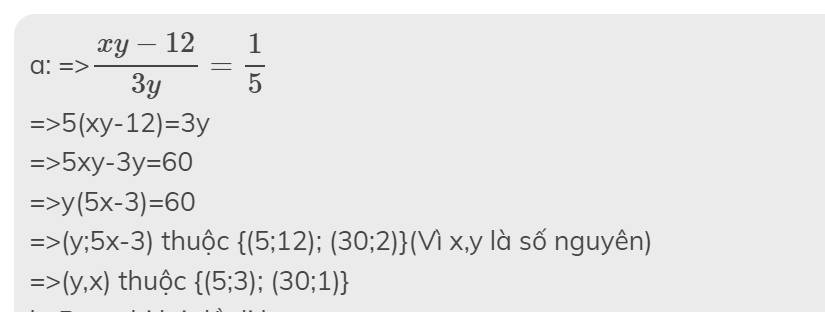Tìm số tự nhiên x sao cho:
a) 2/3 * 3/4 * x/5 bằng 2*3*7/3*4*5
b) x/5*5/6*9 bằng 4*5*9/5*6
Hãy nhập câu hỏi của bạn vào đây, nếu là tài khoản VIP, bạn sẽ được ưu tiên trả lời.


b: 4/x+y/3=5/6
=>\(\dfrac{12+xy}{3x}=\dfrac{5}{6}=\dfrac{5x}{6x}\)
=>24+2xy=5x
=>5x-2xy=24
=>x(5-2y)=24
=>x(2y-5)=-24
=>(x;2y-5) thuộc {(24;-1); (-24;1); (8;-3); (-8;3)}(Vì x và y là số nguyên)
=>(x,y) thuộc {(24;2); (-24;3); (8;1); (-8;1)}

a: =>\(\dfrac{xy-12}{3y}=\dfrac{1}{5}\)
=>5(xy-12)=3y
=>5xy-3y=60
=>y(5x-3)=60
=>(y;5x-3) thuộc {(5;12); (30;2)}(Vì x,y là số nguyên)
=>(y,x) thuộc {(5;3); (30;1)}
b: Bạn ghi lại đề đi bạn

1: Để 2/x là số tự nhiên thì \(\left\{{}\begin{matrix}\dfrac{2}{x}>0\\x\inƯ\left(2\right)\end{matrix}\right.\Leftrightarrow x\in\left\{1;2\right\}\)
2: Để 3/x là số tự nhiên thì \(\left\{{}\begin{matrix}\dfrac{3}{x}>0\\x\inƯ\left(3\right)\end{matrix}\right.\Leftrightarrow x\in\left\{1;3\right\}\)
3: Để 4/x là số tự nhiên là \(\left\{{}\begin{matrix}\dfrac{4}{x}>0\\x\inƯ\left(4\right)\end{matrix}\right.\Leftrightarrow x\in\left\{1;2;4\right\}\)
4: Để 5/x là số tự nhiên thì \(\left\{{}\begin{matrix}\dfrac{5}{x}>0\\x\inƯ\left(5\right)\end{matrix}\right.\Leftrightarrow x\in\left\{1;5\right\}\)
5: Để 6/x là số tự nhiên thì \(\left\{{}\begin{matrix}\dfrac{6}{x}>0\\x\inƯ\left(6\right)\end{matrix}\right.\Leftrightarrow x\in\left\{1;2;3;6\right\}\)
6: Để 9/x+1 là số tự nhiên thì \(\left\{{}\begin{matrix}x+1>0\\x+1\inƯ\left(9\right)\end{matrix}\right.\Leftrightarrow x+1\in\left\{1;3;9\right\}\)
=>\(x\in\left\{0;2;8\right\}\)
7: Để 8/x+1 là số tự nhiên thì
\(\left\{{}\begin{matrix}x+1\inƯ\left(8\right)\\x+1>0\end{matrix}\right.\)
=>x+1 thuộc {1;2;4;8}
=>x thuộc {0;1;3;7}
8: Để 7/x+1 là số tự nhiên thì
x+1>0 và x+1 thuộc Ư(7)
=>x+1 thuộc {1;7}
=>x thuộc {0;6}
9: Để 6/x+1 là số tự nhiên thì
x+1>0 và x+1 thuộc Ư(6)
=>x+1 thuộc {1;2;3;6}
=>x thuộc {0;1;2;5}
10: Để 5/x+1 là số tự nhiên thì
x+1>0 và x+1 thuộc Ư(5)
=>x+1 thuộc {1;5}
=>x thuộc {0;4}

2:
a: 5/x-y/3=1/6
=>\(\dfrac{15-xy}{3x}=\dfrac{1}{6}\)
=>\(\dfrac{30-2xy}{6x}=\dfrac{x}{6x}\)
=>30-2xy=x
=>x(2y+1)=30
=>(x;2y+1) thuộc {(30;1); (-30;-1); (10;3); (-10;-3); (6;5); (-6;-5)}
=>(x,y) thuộc {(30;0); (-30;-1); (10;1); (-10;-2); (6;2); (-6;-3)}
b: x/6-2/y=1/30
=>\(\dfrac{xy-12}{6y}=\dfrac{1}{30}\)
=>\(\dfrac{5xy-60}{30y}=\dfrac{y}{30y}\)
=>5xy-60=y
=>y(5x-1)=60
=>(5x-1;y) thuộc {(-1;-60); (4;15); (-6;-10)}(Vì x,y là số nguyên)
=>(x,y) thuộc {(0;-60); (1;15); (-1;-10)}

Bài 1:
a) Ta có: \(\dfrac{2}{5}\cdot x+\dfrac{1}{3}=\dfrac{1}{5}\)
\(\Leftrightarrow\dfrac{2}{5}\cdot x=\dfrac{1}{5}-\dfrac{1}{3}=\dfrac{-2}{15}\)
\(\Leftrightarrow x=\dfrac{-2}{15}:\dfrac{2}{5}=\dfrac{-2}{15}\cdot\dfrac{5}{2}\)
hay \(x=-\dfrac{1}{3}\)
Vậy: \(x=-\dfrac{1}{3}\)
b) Ta có: \(\dfrac{1}{5}+\dfrac{5}{3}:x=\dfrac{1}{2}\)
\(\Leftrightarrow\dfrac{5}{3}:x=\dfrac{1}{2}-\dfrac{1}{5}=\dfrac{3}{10}\)
\(\Leftrightarrow x=\dfrac{5}{3}:\dfrac{3}{10}=\dfrac{5}{3}\cdot\dfrac{10}{3}\)
hay \(x=\dfrac{50}{9}\)
Vậy: \(x=\dfrac{50}{9}\)
c) Ta có: \(\dfrac{4}{9}-\dfrac{5}{3}\cdot x=-2\)
\(\Leftrightarrow\dfrac{5}{3}x=\dfrac{4}{9}+2=\dfrac{22}{9}\)
\(\Leftrightarrow x=\dfrac{22}{9}:\dfrac{5}{3}=\dfrac{22}{9}\cdot\dfrac{3}{5}\)
hay \(x=\dfrac{22}{15}\)
Vậy: \(x=\dfrac{22}{15}\)
d) Ta có: \(\dfrac{5}{7}:x-3=\dfrac{-2}{7}\)
\(\Leftrightarrow\dfrac{5}{7}:x=\dfrac{-2}{7}+3=\dfrac{19}{21}\)
\(\Leftrightarrow x=\dfrac{5}{7}:\dfrac{19}{21}=\dfrac{5}{7}\cdot\dfrac{21}{19}\)
hay \(x=\dfrac{15}{19}\)
Vậy:\(x=\dfrac{15}{19}\)

a: \(\Leftrightarrow-4< =x< =-3\)
hay \(x\in\varnothing\)
b: =>-9<x<=3
hay \(x\in\left\{0;1;2;3\right\}\)

`@` `\text {Ans}`
`\downarrow`
`2+(x+3)=7`
`\Rightarrow x+3=7-2`
`\Rightarrow x+3=5`
`\Rightarrow x=5-3`
`\Rightarrow x=2`
`5+(3+x)=10`
`\Rightarrow 3+x=10-5`
`\Rightarrow 3+x=5`
`\Rightarrow x=5-3`
`\Rightarrow x=2`
`(4+x)+1=7`
`\Rightarrow 4+x=7-1`
`\Rightarrow 4+x=6`
`\Rightarrow x=6-4`
`\Rightarrow x=2`
`(x+5)+3=9`
`\Rightarrow x+5=9-3`
`\Rightarrow x+5=6`
`\Rightarrow x=6-5`
`\Rightarrow x=1`
`(x-1)-4=7`
`\Rightarrow x-1=7+4`
`\Rightarrow x-1=11`
`\Rightarrow x=11+1`
`\Rightarrow x=12`
`4-(6-x)=1`
`\Rightarrow 6-x=4-1`
`\Rightarrow 6-x=3`
`\Rightarrow x=6-3`
`\Rightarrow x=3`
\(2+\left(x+3\right)=7\)
\(\Rightarrow2+x+3=7\)
\(\Rightarrow x+5=7\)
\(\Rightarrow x=2\)
\(5+\left(3+x\right)=10\)
\(\Rightarrow5+3+x=10\)
\(\Rightarrow x+8=10\)
\(\Rightarrow x=2\)
\(\left(4+x\right)+1=7\)
\(\Rightarrow4+x+1=7\)
\(\Rightarrow x+5=7\)
\(\Rightarrow x=2\)
\(\left(x+5\right)+3=9\)
\(=x+5+3=9\)
\(\Rightarrow x+8=9\)
\(\Rightarrow x=1\)
\(\left(x-1\right)-4=7\)
\(\Rightarrow x-1-4=7\)
\(\Rightarrow x-5=7\)
\(\Rightarrow x=12\)
\(4-\left(6-x\right)=1\)
\(\Rightarrow4-6-x=1\)
\(\Rightarrow-2-x=1\)
\(\Rightarrow x=-3\)